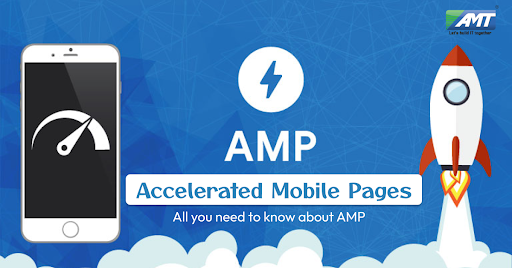AMP (Accelerated Mobile Pages) is a web component framework and a website publishing technology developed by Google which has the mission to “provide a user-first format for web content”.
The AMP Project was announced by Google on October 7, 2015 following discussions with its partners in the Digital News Initiative (DNI), and other news publishers and technology companies around the world, about improving the performance of the mobile web. More than 30 news publishers and several technology companies (including Twitter, Pinterest, LinkedIn and WordPress) were initially announced as collaborators in the AMP Project.
AMP pages first appeared to web users in February 2016, when Google began to show the AMP versions of web-pages in mobile search results. Initially links to AMP pages were restricted to a “Top Stories” section of Google’s mobile search results; by September 2016 Google started linking to AMP content in the main mobile search results area. AMP links in Google search are identified with an icon.
According to one of the co-founders of the AMP Project, Malte Ubl, AMP was originally called PCU, which stood for Portable Content Unit.
AMP HTML:
The AMP framework consists of three components: AMP HTML, which is standard HTML markup with web components; AMP JavaScript, which manages resource loading; and AMP caches, which serve and validate AMP pages.
Most AMP pages are delivered by Google’s AMP cache, but other companies can support AMP caches. Internet performance and security company Cloud flare launched an AMP cache in March 2017.
AMP Stories:
In 2018, Google introduced AMP Stories, a visually tappable experiences that provides content publishers with a mobile-focused format for delivering news and information as visually rich, tap-through stories. In 2019, they announced that they will be rolling out new dedicated placement on the SERP for AMP Stories, starting with travel category first. On April 17, on their AMP Conference in Tokyo, they also announced ads and Google Analytics integration, and option to embed new types of content — specifically Twitter posts, Google Maps, and YouTube videos that they will be rolling out later in 2019.
AMP Stories Editors and Builders:
Since Google launched the AMP Story format, there have been a number of new SaaS that offer fast, no-code option to create AMP Stories. These tools are fit for content publishers who want to exploit the new technology, but do not know how to code, or wish to publish content in an accelerated manner without manually defining styling and layout.
AMP Email:
In 2019, Google announced the new AMP Email section of the AMP framework. AMP for email allows senders to include AMP components inside rich engaging emails, making modern app functionality available within email. The AMP email format provides a subset of AMPHTML components for use in email messages, that allows recipients of AMP emails to interact dynamically with content directly in the message.
Online Format:
AMP pages are published on-line and can be displayed in most current browsers. When a standard web-page has an AMP counterpart, a link to the AMP page is usually placed in an HTML tag in the source code of the standard page. Because most AMP pages are easily discover-able by web crawlers, third parties such as search engines and other referring websites can choose to link to the AMP version of a web-page instead of the standard version.
Third party integration:
Any organization or individual can build products or features which will work on AMP pages, provided they comply with the AMP Project specifications. As of July 2017, the AMP Project’s website listed around 120 advertising companies and around 30 analytics companies as AMP Project participants.
Performance:
Google reports that AMP pages served in Google search typically load in less than one second and use ten times less data than the equivalent non-AMP pages. CNBC reported a 75% decrease in mobile page load time for AMP Pages over non-AMP pages, while Gizmodo reported that AMP pages loaded three times faster than non-AMP pages.
An academic paper about AMP reveals that AMP pages’ page load time is 2.5 times faster than non-AMP versions without pre-rendering in Google’s search result page, and the AMP version is approximately nine times faster than the non-AMP version with the pre-rendering.
Parity with canonical pages:
Google has announced that as of February 1, 2018, it will require the content of canonical pages and those displayed through AMP be substantially the same. This is aimed at improving the experience of users by avoiding common difficulties with the user interface, and increase security and trust (see below).
The above is a brief about Accelerated Mobile Pages. Watch this space for more updates on the latest trends in Technology.
